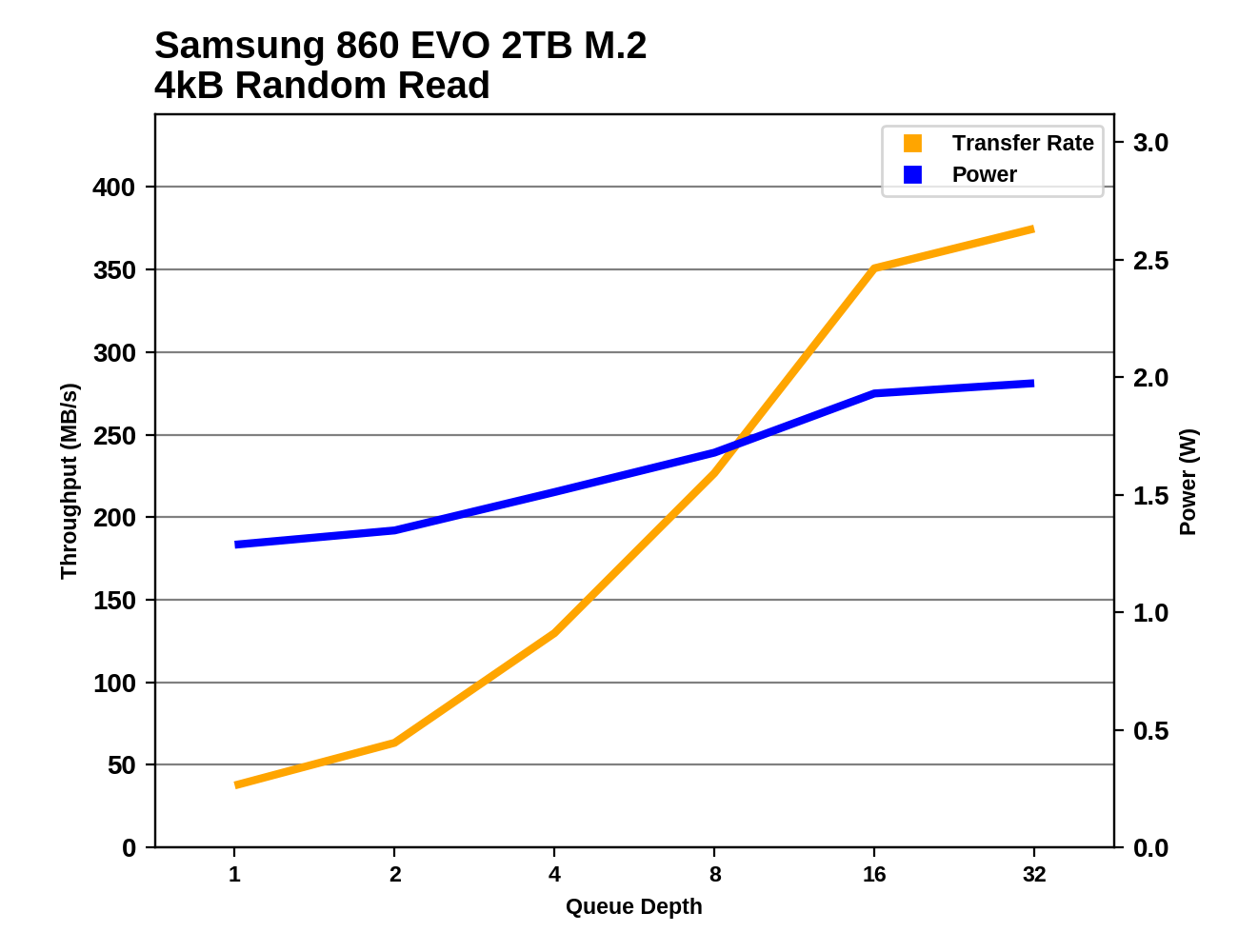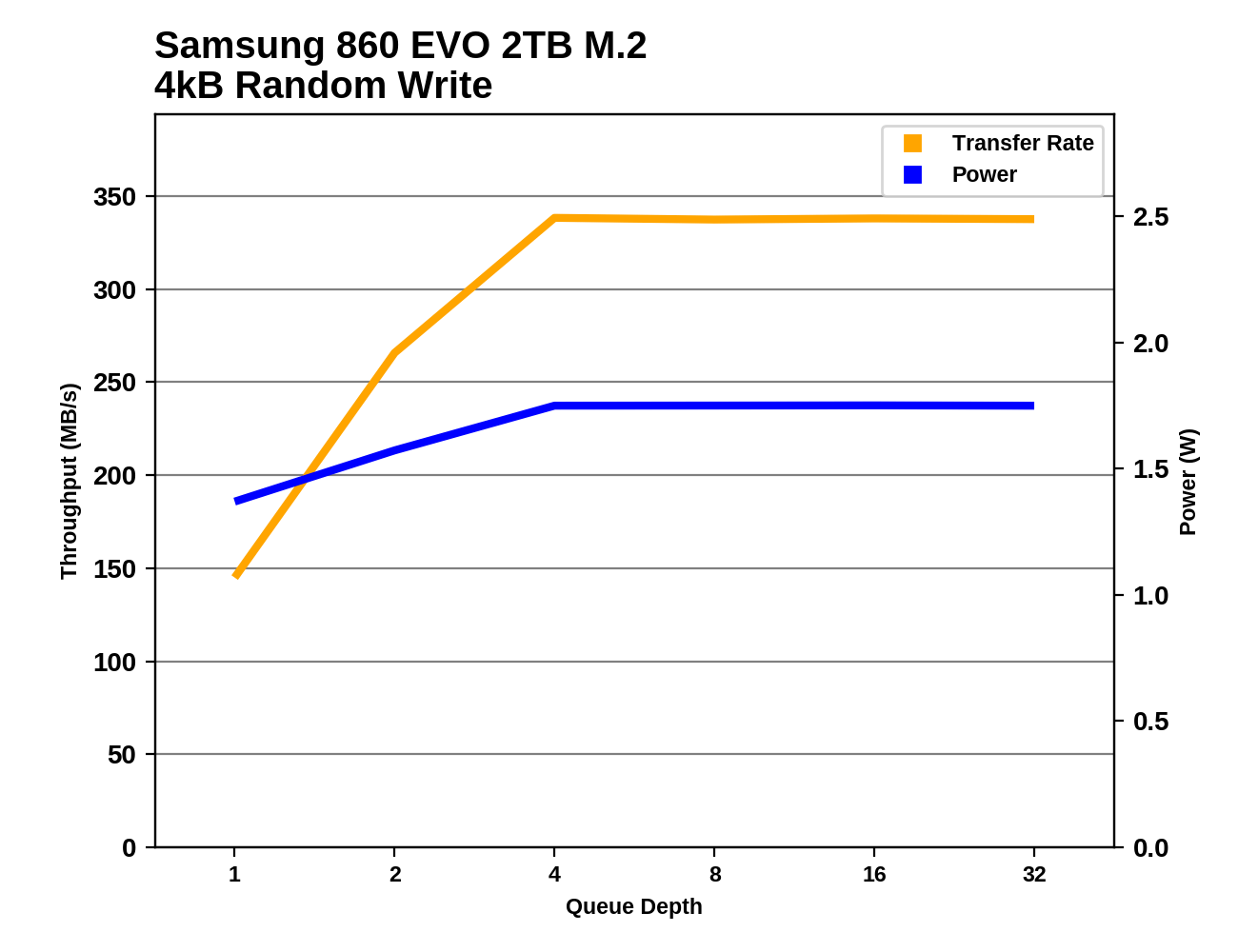The Latest High-Capacity M.2: The Samsung 860 EVO 2TB SSD, Reviewed
by Billy Tallis on February 14, 2018 1:40 PM ESTRandom Read Performance
Our first test of random read performance uses very short bursts of operations issued one at a time with no queuing. The drives are given enough idle time between bursts to yield an overall duty cycle of 20%, so thermal throttling is impossible. Each burst consists of a total of 32MB of 4kB random reads, from a 16GB span of the disk. The total data read is 1GB.

The Samsung 860 EVO's burst random read speed is a bit slower than that of the 850 EVO, and both drives are slower than the fastest competing 3D TLC drives.
Our sustained random read performance is similar to the random read test from our 2015 test suite: queue depths from 1 to 32 are tested, and the average performance and power efficiency across QD1, QD2 and QD4 are reported as the primary scores. Each queue depth is tested for one minute or 32GB of data transferred, whichever is shorter. After each queue depth is tested, the drive is given up to one minute to cool off so that the higher queue depths are unlikely to be affected by accumulated heat build-up. The individual read operations are again 4kB, and cover a 64GB span of the drive.

On the longer random read test with some higher queue depths, Samsung retakes their position of having the fastest TLC drive, though not by a significant margin. The MLC-based 850 PRO and 860 PRO have a substantial advantage.

The power efficiency of the 860 EVO is much better than the 850 EVO, but it's only enough to bring it in line with its current competition. The improvement doesn't even come close to the 860 PRO's impressive boost in efficiency.
 |
|||||||||
The 3D TLC drives in this bunch (with the exception of the outgoing Crucial MX300) all show very similar random read performance scaling as queue depths increase. The Crucial MX500 lags a bit at high queue depths, but all of the current-generation drives top out at about the same speed. The 860 PRO is significantly faster across the entire test while using about the same amount of power.
Random Write Performance
Our test of random write burst performance is structured similarly to the random read burst test, but each burst is only 4MB and the total test length is 128MB. The 4kB random write operations are distributed over a 16GB span of the drive, and the operations are issued one at a time with no queuing.

The burst random write speed of the 860 EVO is improved significantly over the 850 EVO, but Crucial's SLC write caches on the MX300 and MX500 are still faster.
As with the sustained random read test, our sustained 4kB random write test runs for up to one minute or 32GB per queue depth, covering a 64GB span of the drive and giving the drive up to 1 minute of idle time between queue depths to allow for write caches to be flushed and for the drive to cool down.

The sustained random write performance of the Samsung 860 EVO is about the same as the 860 PRO, and is a bit ahead of the competing TLC drives. This is one test where the 1TB models from Crucial and SanDisk appear to be at a disadvantage due to their lower capacities, so a fairer test against the 2TB models of those products would probably show a substantially smaller lead for the 860 EVO.

The 860 EVO's jump in power efficiency is almost as large as the 860 PRO's improvement. This puts the 860 EVO well ahead of the competing TLC SSDs.
 |
|||||||||
Most of these SSDs reach full random write speed at QD4. The 1TB Crucial MX500 is the noticeable outlier with much slower performance growth that doesn't reach full speed until QD16. The 1TB SanDisk Ultra 3D saturates at QD4, but with throughput that is far below the Samsung drives. Even the remarkably power-efficient (for its time) Crucial MX300 uses more power than the 860 EVO, while delivering slightly lower performance.










32 Comments
View All Comments
Reflex - Wednesday, February 14, 2018 - link
https://www.amazon.com/gp/product/B01LB05YOO/Micron 1100 2TB for $379
This is basically a clone of the MX300 marketed to IT departments. Cheaptest 2TB SATA option I've seen by far, and gets good reviews, essentially identical to the MX300 (same hardware, no surprise) but has a better warranty I believe.
CherryBOMB - Wednesday, February 14, 2018 - link
Thanks for the information comment on your experience.bug77 - Wednesday, February 14, 2018 - link
I wonder what kind of warranty you get with those, since Micron branded products are not usually meant for retail.Reflex - Wednesday, February 14, 2018 - link
https://www.nikktech.com/main/articles/pc-hardware...According to this review of the 256GB model of this drive, it is a 5 year warranty.
Reflex - Wednesday, February 14, 2018 - link
The Crucial MX300 that it is a clone of has only a 3 year warranty, for reference.bug77 - Friday, February 16, 2018 - link
Actually, in the provided Amazon link, the first question is about warranty and the seller says it's 3 years. I was just afraid these were sold as stripped parts and wouldn't be covered, but it seems that not the case.Reflex - Friday, February 16, 2018 - link
The seller is not the OEM however, it's a third party. I have no idea if that is correct or the review I linked was correct. Micron's site is not helpful.xrror - Thursday, February 15, 2018 - link
How long has this drive been out???! Because I've been looking for an affordable 2TB option for the past half year and can't believe I never found this one.Thanks for the heads up on this model.
Reflex - Thursday, February 15, 2018 - link
I am unclear on how long it has been out, the review I linked is from late 2016, but the Amazon page implies its only been there since late 2017. My guess is its only sold into enterprise settings and a seller with stock listed it on Amazon. Regardless, its a great price for a brand that isn't questionable.Reflex - Saturday, February 17, 2018 - link
In case anyone is tracking this: I got mine in the mail yesterday. It is definitely intended for OEM markets, it came in a sealed anti-static bag with no other packaging. That said I popped it into a system and it was immediately recognized and is the capacity expected. No problems at all.